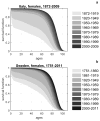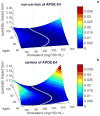How the effects of aging and stresses of life are integrated in mortality rates: insights for genetic studies of human health and longevity
- PMID: 26280653
- PMCID: PMC4724574
- DOI: 10.1007/s10522-015-9594-8
How the effects of aging and stresses of life are integrated in mortality rates: insights for genetic studies of human health and longevity
Abstract
Increasing proportions of elderly individuals in developed countries combined with substantial increases in related medical expenditures make the improvement of the health of the elderly a high priority today. If the process of aging by individuals is a major cause of age related health declines then postponing aging could be an efficient strategy for improving the health of the elderly. Implementing this strategy requires a better understanding of genetic and non-genetic connections among aging, health, and longevity. We review progress and problems in research areas whose development may contribute to analyses of such connections. These include genetic studies of human aging and longevity, the heterogeneity of populations with respect to their susceptibility to disease and death, forces that shape age patterns of human mortality, secular trends in mortality decline, and integrative mortality modeling using longitudinal data. The dynamic involvement of genetic factors in (i) morbidity/mortality risks, (ii) responses to stresses of life, (iii) multi-morbidities of many elderly individuals, (iv) trade-offs for diseases, (v) genetic heterogeneity, and (vi) other relevant aging-related health declines, underscores the need for a comprehensive, integrated approach to analyze the genetic connections for all of the above aspects of aging-related changes. The dynamic relationships among aging, health, and longevity traits would be better understood if one linked several research fields within one conceptual framework that allowed for efficient analyses of available longitudinal data using the wealth of available knowledge about aging, health, and longevity already accumulated in the research field.
Keywords: Genetic heterogeneity; Health of the elderly; Longitudinal data; Pleiotropy; Population aging; Quadratic hazard.
Figures





References
-
- Aalen OO. Effects of frailty in survival analysis. Stat Methods Med Res. 1994;3:227–243. - PubMed
-
- Abbring JH, Van den Berg GJ. The unobserved heterogeneity distribution in duration analysis. Biometrika. 2007;94:87–99. doi: 10.1093/biomet/asm013. - DOI
-
- Abelson PH. Improvements in health care. Science. 1993;260:11. - PubMed
Publication types
MeSH terms
Substances
Grants and funding
- N02 HL064278/HL/NHLBI NIH HHS/United States
- P30 AG034424/AG/NIA NIH HHS/United States
- R01AG046860/AG/NIA NIH HHS/United States
- N01 HC025195/HL/NHLBI NIH HHS/United States
- R01 AG046860/AG/NIA NIH HHS/United States
- P01 AG043352/AG/NIA NIH HHS/United States
- N02-HL-64278/HL/NHLBI NIH HHS/United States
- RF1 AG046860/AG/NIA NIH HHS/United States
- R01 AG028259/AG/NIA NIH HHS/United States
- P30AG034424/AG/NIA NIH HHS/United States
- N01-HC-25195/HC/NHLBI NIH HHS/United States
- R01 AG027019/AG/NIA NIH HHS/United States
- P01AG043352/AG/NIA NIH HHS/United States
LinkOut - more resources
Full Text Sources
Other Literature Sources
Medical

